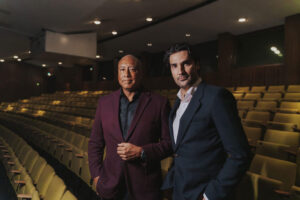Although Richard Wagner erected the work as a monument to love, Nike Wagner asserts that the text’s philosophically rich dialectic presents the radical love expounded upon in the central act as fundamentally intertwined with a longing for death and a dissolution of identity, ultimately expressing “a desire for regression…into blissful former times.”
Director Thorleifur Örn Arnarsson’s new production of Tristan und Isolde for the Bayreuth Festival embodies this concept by anchoring the lovers to a pivotal moment from the anterior plot: the pair’s fateful gaze and their realization of desire while Isolde nursed the wounded “Tantris.” Arnarsson and his dramaturge Andri Hardmeier’s esoteric, deconstructionist staging centers around the lovers’ attempts to restore this overwhelming moment of self-recognition, their philosophical and emotional scleroses binding the characters towards the ending’s cathartic acts of self-destruction.
As the prelude concludes, the curtain rises to reveal Tristan’s ship, a space consistently transformed by its set designer Vytautas Narbutas as a locus for Arnarsson’s vision. The lovers and their entourage occupy the vessel’s deck, the scene bleak and enshrouded in a persistent darkness. Two striking set pieces in the first act emerge as the staging’s thematic anchors: ropes that hang precariously from overhead, and Isolde’s oversized wedding dress with its stage-spanning train (designed by Sibylle Wallum), upon which she furiously scribbles phrases from her soliloquys and imprecations. Arnarsson anoints Isolde as the mistress of his vision’s narrative, her words conferring her with the agency to subvert the power politics imposed upon her by her captors.
Isolde traverses a searing emotional arc as she grapples with the realization of Tristan’s deceit, his denial of their mutual desire, and ultimately his betrayal of himself and his will. In his production, Arnarsson uses Isolde’s penetrating psychological depth to empower her with the ability to gradually strip away Tristan’s heroic façade. Tristan accepts Isolde’s poison as atonement for his actions, his willingness to embrace death a tacit admission of his love. In a departure from the libretto, Isolde knocks the Liebestrank from Tristan’s hand, liberating them from its external spell and the diurnal laws of social responsibility. When the first act closes, the ropes fall from the ceiling and the lovers descend further inward into the vessel’s interior.
Rather than staging Act II in King Marke’s castle, Narbutas sets the action within the hold of Tristan’s ship, emphasizing the lovers’ inability to escape the site of their fateful reunion. The rusted ruin of the vessel’s underbelly becomes a reliquary for looted art symbolizing Romanticism (one noted example being Caspar David Friedrich’s “Ships in the Harbor of Greifswald,” its imagery of vessels sailing against a melancholic seascape mirroring the main characters’ isolation and yearning), alongside old Bayreuth set pieces (Herheim’s clock from Parsifal) and treasures and artifacts emblematic of idealized heroism and womanhood.
Tristan and Isolde meander around this space and confront these objects of cultural memory as they philosophize about their consecration to the night. When Tristan rediscovers the sword that granted Isolde authority over Tantris’s life, he offers her the weapon as another gesture of atonement and surrender. Isolde’s refusal to kill him then serves as the transition point for the lovers embarking on the opera’s magnificent love duet.
Unlike traditional readings that stage the meditative “O sink hernieder Nacht” as a blissful but fleeting consummation, Arnarsson’s production sees the lovers continue to explore this music in isolation, each confronting the relics of their past identities as an exercise in self-abandonment. This dramaturgic treatment is distinctly Schopenhauerian, reflecting the dissolution of the individual will into a transcendent, universal “we.” Only upon hearing Brangäne’s warning do the lovers finally share an intimate embrace. Following King Marke’s interruption of the lovers, Arnarsson concludes the second act not with Tristan being injured by Melot’s sword, but by his consumption of the Todestrank.
In the final act, Narbutas deconstructs Tristan’s ship and scatters its remnants amid a chthonic representation of limbo, the hero’s watchers being Kurwenal and the shepherd dressed in angelic garb. The dying Tristan, clad in a tunic fashioned from Isolde’s wedding train, lies upon a scrap heap of outdated symbols of masculine heroism. As he cycles through stages of mania and delirium, Tristan interacts with the wreckages of his ship and his past, at times even covering himself with Isolde’s train.
The act’s conclusion eschews the collateral damage of Melot and Kurwenal’s deaths, instead focusing on the lovers’ self-abandonment and the dissolution of their individual identities. Isolde’s Liebestod culminates as an act of suicide too as she partakes of the Todestrank, clutching the production’s symbolic wedding train as she attains her state of self-realization through oblivion.
Arnarsson’s vision of Tristan initially presents a dizzying array of symbols that, while initially incoherent, gradually reveals a wealth of detail that underscores the libretto’s rich Schopenhauerian themes. Hardmeier’s non-interventionist approach aptly serves the interior nature of the drama in allowing the narrative to unfold as a rich psychological discourse between two central characters. However, some directorial choices could occasionally be opaque: Kurwenal and Brangäne often appear to be left without specific direction for much of their time on stage, and King Marke’s aggressive portrayal doesn’t convincingly tie with the direction vision of subverting the supporting characters’ motivations to the leads’ overwhelming will.
Perhaps most critically, the psychological motivations that depict how Tristan and Isolde find their way to death and their relation to the production’s collection of symbols is portrayed inconsistently. For instance, the lovers’ reliance on Isolde’s train as a plot device for Arnarsson’s death-devoted thesis convinces in its deployment throughout the opera. However, the iconography behind the clutter in the latter acts could be challenging to decipher without painstakingly combing through the pieces and their artistic relevance. While Arnarsson’s production could be psychologically fascinating in its exploration of the work’s Schopenhauerian underpinnings, it would greatly benefit from revivals that emphasize greater directorial clarity and more purposeful character motivation through its existence in the Festival.
Two performances inform the musical discussion covered in this review: the Tristans presented at Bayreuth on August 3 and August 6. Though largely enjoyable, both iterations contained sufficient differences in technical execution that reveal how musicians interact with this incredibly difficult and thematically complex work.
Semyon Bychkov led the Bayreuth Festival Orchestra in a deeply expressive and beautifully textured reading of the score, his surging orchestral paragraphs seamless in their navigation of Wagner’s instrumental transformations. Bychkov underscored the Romantic character of this work, with the Sehnsuchtmotiv and the Liebestrank music emerging with clarity and emotional power throughout the first act prelude. He likewise imparted an ethereal and haunting quality to the elegiac music of the third act prelude and etched an accompaniment brimming with yearning and suffering for Tristan’s deliriums.
Throughout both performances, critical instrumental voices like the cor anglais, the clarinets, the cellos, and the bass clarinet wove in and out of the orchestral backdrop to color the libretto’s emotionally rich narrative. On the technical side, Bychkov and his orchestra encountered some brass/wind coordination issues within the pit and with the singers during the performance of August 3 and erred on rather loud balances that threated to overpower the singers even within the voice-friendly Festspielhaus. The performance of August 6 was superior, the tempi more judiciously paced with his artists, the volumes tempered and the overall arc of the work achieving an emotionally coherent through line.
Camilla Nylund proved a most formidable and intelligent Isolde, particularly during the performance of August 6. Earlier reviews noted that her interpretation and vocal approach erred on the more lyrical side, and while that characteristic was true for the Isolde of August 3, her voice on August 6 acquired a timbral strength and freedom across her vocal registers that capably filled Act I’s tempestuous dramatic lines.
Nylund’s Isolde captured the full spectrum of the character’s pride, irony, and sarcasm. When she traversed through the rich philosophical contours of the central act, her impeccable German diction and her word painting unveiled the beauty and the emotional of depth of Wagner’s writing. While hers isn’t the Isolde of a traditional hochdramatischer soprano, Nylund creation nevertheless demonstrates her domination over this role’s fiendish technicalities and her ownership of its fascinating dramatic possibilities.
It should be noted that Andreas Schager’s contributions to both performances were affected by an upper respiratory infection that felled his voice during the second performance. Schager’s Heldentenor has been acclaimed for his robust timbre, ease of production and reliable staying power in the Strauss and Wagner repertory for the better part of a decade. His Tristan under more optimal conditions is a formidable creation, capable of expressing the character’s impassioned outburst and his deliriums with heroic abandon.
During the Tristan of August 3, Schager delivered a credible, fervid performance through the vocally challenging “Tag und Nacht” exchange with Isolde. When he had to tame his voice for the more tender parts of the love duet, his vocal control loosened. If his performance during the third act conveyed the character’s suffering and longing for death, the integrity of the musical line was at times compromised. When Schager returned to the Festspielhaus stage on August 6, he was noticeably marking through the performance, and by the third act, he was replaced vocally by his cover Tilmann Unger after Tristan’s harrowing “Noch losch das Licht nicht aus.” Unger, possessing a timbre reminiscent of Jess Thomas’, sang the role plausibly at the side of the stage while Schager mimed the part. While this isn’t an ideal circumstance for a vocalist of Schager’s stature, both singers were applauded for completing this immensely difficult act under duress.
Among the supporting soloists, the veteran mezzo soprano Christa Mayer impressed for conveying an assertive Brangäne of intelligence, depth and experience. Her intimate understanding about sculpting a Wagnerian line with her scene partners resulted in one of this production’s most satisfying musical performances. Olafur Sigurdarson wielded his tight and bright character baritone as Kurwenal and presented a blunter and gruffer portrayal than what is vocally ideal. The character’s hymn of praise to Tristan in the first act and his dialogue with his dying friend in the final act lack qualities of simpatico and sensitivity.
As King Marke, Günther Groissböck’s vocal production varied in quality between the two performances. The Austrian bass’s voice was darker, more resonant and evenly produced on August 3, but sounded strained and colorless as the vocal line ascended during the performance of August 6. Groissböck’s snarling interpretation, in combination with his vocal production’s unusual jaw manipulations, portrayed a cruel reading of the character that appeared to contradict the production’s concept. The smaller roles are aptly well taken by a younger generation of artists: the tenors Matthew Newlin and Daniel Lenz sing the brief, yet evocative parts of the Sailor and Shepherd with beautiful, floating lyric tenor voices, whereas Birger Radde’s Melot imposes a significant presence onstage despite the liberties Arnarsson takes on his character’s direction.
Despite the inconsistencies in Arnarsson’s dramaturgic execution and the musicians’ occasional issues, both performances of Tristan und Isolde transcended these challenges and delivered enjoyable, emotionally resonant, and even profoundly moving theater.
Photos: Enrico Nawrath




